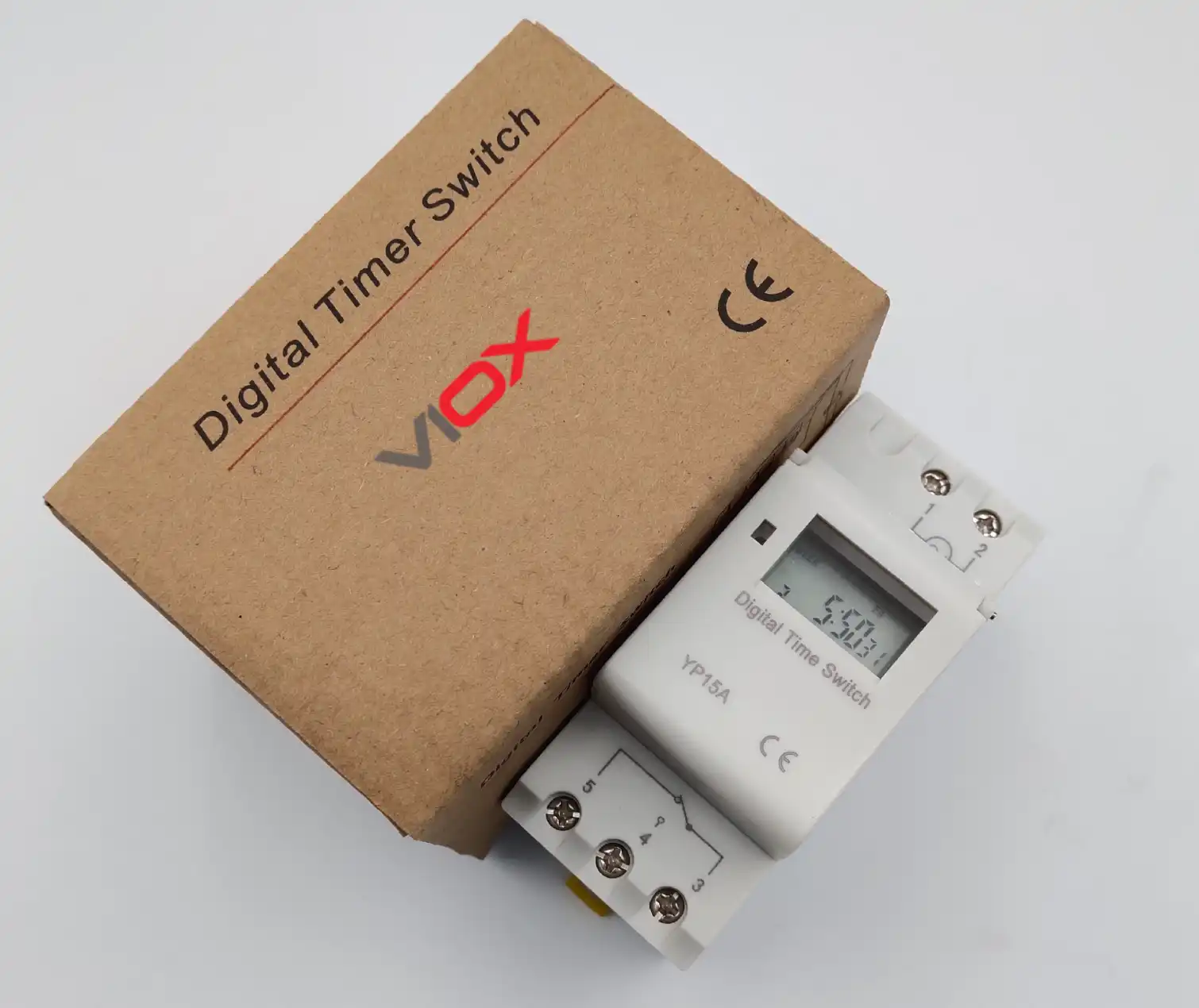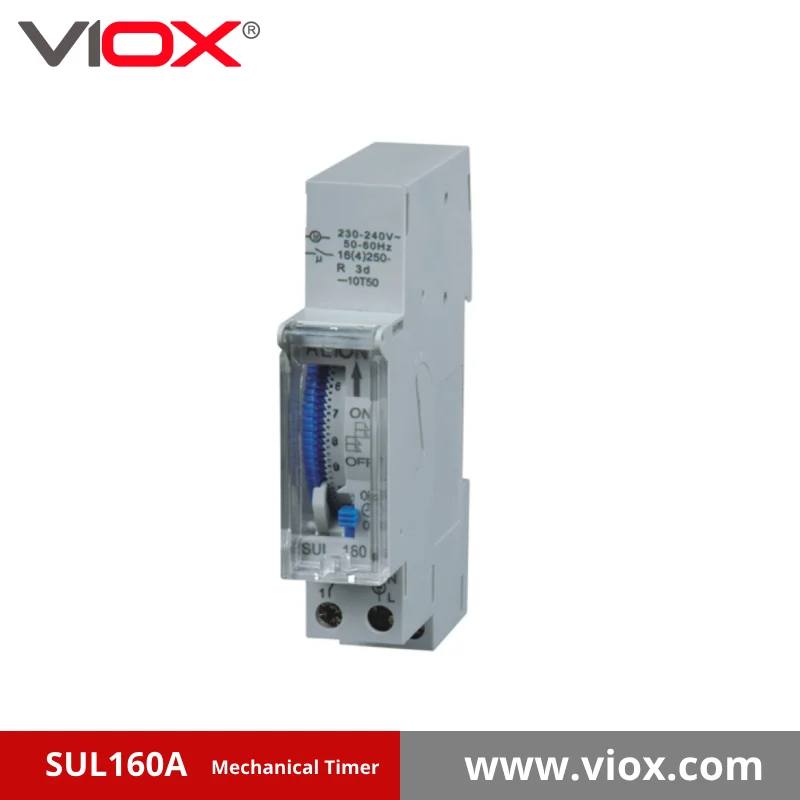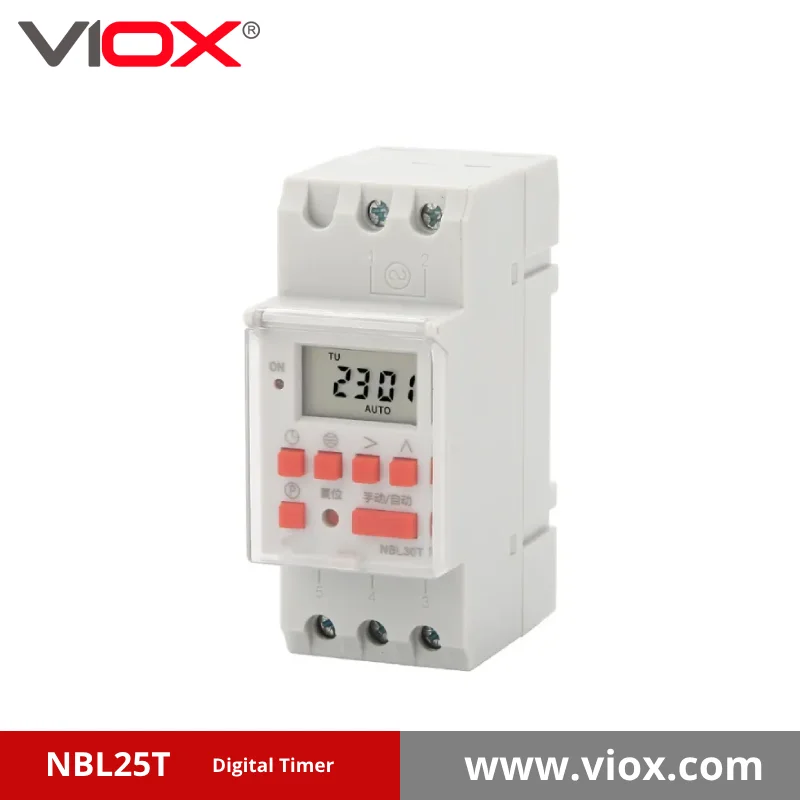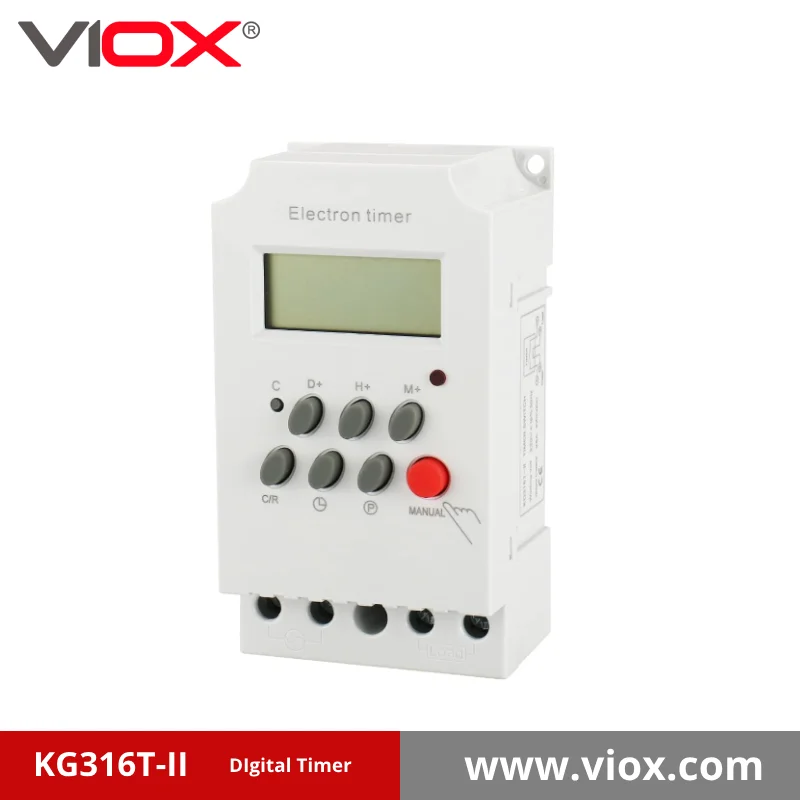A timer switch is an electrical control device that automatically turns electrical circuits on and off at predetermined times, providing convenient automation for lighting, heating, cooling, and other electrical systems. Timer switches save energy, improve security, and eliminate the need for manual operation of electrical devices, making them essential components in modern residential, commercial, and industrial applications.
Understanding timer switch types, functions, and applications helps you choose the right automation solution for your specific needs while ensuring safety, compliance, and optimal performance.
What Is a Timer Switch and How Does It Work?
A timer switch replaces conventional wall switches to provide automated control of electrical circuits. These devices operate by using internal timing mechanisms—either mechanical clockwork, digital microprocessors, or smart connectivity—to control when electrical power flows to connected devices.
Key Components of Timer Switches:
- Timing Mechanism: Controls when switching occurs (mechanical, digital, or smart)
- Switch Contacts: Heavy-duty contacts that handle electrical loads
- Control Interface: Programming method (dials, buttons, or apps)
- Strömförsörjning: Internal power source for timing functions
- Load Terminals: Connection points for electrical circuits
Timer Switch Types: Complete Comparison Guide
Mechanical Timer Switches
How They Work: Mechanical timer switches use a synchronous motor that drives a gear train at constant speed, similar to a clock mechanism. Removable pins or tabs around a rotating dial determine when the switch activates.
Viktiga egenskaper:
- Noggrannhet: ±2-5 minutes typical deviation
- Programming: Manual adjustment via rotating dial with removable pins
- Strömförbrukning: 1-2 watts, some models operate without electricity
- Livslängd: 15-20 years typical service life
- Lastkapacitet: 15-30 amps for resistive loads
Best Applications:
- Pool pump filtration cycles
- Outdoor equipment operation
- Simple daily lighting schedules
- Applications where power outages are common
Digital/Electronic Timer Switches
How They Work: Digital timer switches use microcontrollers with quartz crystal oscillators for precise timing. They feature LCD/LED displays and allow multiple daily and weekly programs.
Viktiga egenskaper:
- Noggrannhet: ±2 seconds per day precision
- Programming: Multiple daily/weekly programs (up to 16-32 ON/OFF cycles)
- Avancerade funktioner: Battery backup, holiday mode, manual override, countdown functions
- Strömförbrukning: Approximately 2 watts per hour
- Display: Clear digital readouts showing time and program settings
Best Applications:
- Complex lighting schedules
- Indoor automation systems
- Security lighting with varied patterns
- Commercial building automation
Astronomical Timer Switches
How They Work: Astronomical timers calculate sunrise and sunset times using stored algorithms based on geographic coordinates. They automatically adjust for seasonal changes and daylight saving time.
Viktiga egenskaper:
- Auto-Adjustment: Automatically compensates for seasonal daylight changes
- Noggrannhet: ±1 minute with self-adjusting capability
- Programming: Requires latitude/longitude input or GPS auto-detection
- Seasonal Compensation: Eliminates manual adjustments throughout the year
Best Applications:
- Säkerhetsbelysning utomhus
- Landscape illumination
- Street lighting systems
- Energy-efficient building exteriors
Smart/IoT Timer Switches
How They Work: Smart timer switches connect to home networks via Wi-Fi, Zigbee, or Z-Wave protocols, enabling remote control and advanced automation features through smartphone apps.
Viktiga egenskaper:
- Connectivity: Wi-Fi, Zigbee, Z-Wave, or Bluetooth protocols
- Integration: Compatible with Alexa, Google Home, Apple HomeKit, Samsung SmartThings
- Avancerade funktioner: Voice control, geofencing, energy monitoring, machine learning optimization
- Strömförbrukning: 2-5 watts depending on connectivity
Best Applications:
- Smart home integration
- Remote monitoring and control
- Energy optimization systems
- Modern residential automation
Timer Switch Comparison Table
| Funktion | Mekanisk | Digital | Astronomical | Smart/IoT |
|---|---|---|---|---|
| Noggrannhet | ±2-5 minutes | ±2 seconds/day | ±1 minute | ±1 second |
| Daily Programs | 1 | 1-16 | 1-16 | Unlimited |
| Weekly Programs | Nej | Ja | Ja | Ja |
| Seasonal Adjustment | Manuell | Manuell | Automatisk | Automatisk |
| Fjärrkontroll | Nej | Nej | Begränsad | Ja |
| Installationens komplexitet | Låg | Medium | Medium | Hög |
| Strömförbrukning | 1-2W | ~2W | 2-3W | 2-5W |
| Typical Lifespan | 15-20 år | 8-12 years | 10-15 år | 5–10 år |
| Prisintervall | $6-40 | $20-120 | $30-80 | $30-150 |
Timer Switch Functions and Benefits
Primary Functions
Automated Scheduling: Timer switches eliminate the need for manual operation by automatically controlling electrical circuits based on predetermined schedules. This provides consistent operation regardless of occupancy or user availability.
Energiförvaltning: By controlling when electrical devices operate, timer switches prevent unnecessary energy consumption during unoccupied periods or when equipment isn’t needed.
Security Enhancement: Automated lighting schedules create the appearance of occupancy, deterring potential intruders. Random or varied lighting patterns provide enhanced security benefits.
Skydd av utrustning: Controlled operation cycles extend the lifespan of electrical equipment by preventing continuous operation and reducing wear on motors, bulbs, and other components.
Key Benefits by Application
Bostadsapplikationer:
- Energy Savings: 4-9% automatic electricity savings with proper programming
- Bekvämlighet: Eliminates manual switching for daily routines
- Security: Varied lighting patterns simulate occupancy during vacations
- Kostnadsminskning: Pool timer switches can save $200-400 annually on energy costs
Kommersiella tillämpningar:
- Koden Efterlevs: ASHRAE 90.1 energy efficiency requirements
- Operational Efficiency: 15-20% reduction in utility costs for controlled equipment
- Maintenance Reduction: Scheduled operation reduces equipment wear
- Brand Consistency: Automated scheduling ensures consistent lighting presentation
Industriella tillämpningar:
- Processtyrning: Precise timing for manufacturing and chemical processes
- Säkerhetssystem: Automated testing schedules for emergency equipment
- Energioptimering: Up to 50% energy savings potential in lighting and HVAC systems
- Kvalitetskontroll: Consistent automated schedules ensure reliable processes
Timer Switch Applications Guide
Tillämpningar för bostäder
Styrsystem för belysning
Indoor Automation
- Security Lighting: Deter intruders with varied lighting patterns
- Convenience Scheduling: Automatic operation for daily routines
- Energiförvaltning: Prevent lights from being left on unnecessarily
- Recommended Type: Digital programmable timers for complex schedules
Outdoor Lighting
- Landskapsbelysning: Automatic dusk-to-dawn operation
- Security Lighting: Motion-activated backup with timer override
- Holiday Decorations: Seasonal scheduling with easy programming
- Recommended Type: Astronomical timers for automatic seasonal adjustment
Pool and Spa Equipment
Filtration Systems
- Optimal Operation: 6-8 hours daily for water quality maintenance
- Energieffektivitet: Prevents 24/7 pump operation
- Skydd av utrustning: Controlled cycles extend pump lifespan
- Kostnadsbesparingar: $200-400 annual energy cost reduction
Heating and Chemical Systems
- Precise Timing: Coordinate heating with filtration cycles
- Chemical Dosing: Automated chemical system operation
- Säkerhetsfunktioner: Prevent overheating and chemical overdosing
HVAC and Water Heating
Water Heater Control
- Demand Management: Heat during off-peak hours
- Energieffektivitet: Reduce standby losses during low-demand periods
- Cost Optimization: Take advantage of time-of-use electricity rates
Ventilation Systems
- Bathroom Fans: Automatic operation for humidity control
- Attic Ventilation: Temperature-based operation schedules
- Styrning av luftkvalitet: Consistent ventilation cycling
Kommersiella tillämpningar
Office Building Automation
Belysningssystem
- Parking Lot Control: Astronomical timers with photocell integration
- Interior Lighting: Stairwell, corridor, and conference room automation
- Energy Compliance: Meet ASHRAE 90.1 code requirements
- Kostnadsfördelar: 15-20% reduction in lighting energy costs
HVAC Coordination
- Occupancy-Based Control: Operate systems only during business hours
- Temperature Setbacks: Automatic temperature adjustments for unoccupied periods
- Fresh Air Management: Scheduled ventilation for indoor air quality
Retail and Signage
Displaybelysning
- Storefront Windows: Attractive evening illumination
- Billboard Control: Automated sign lighting schedules
- Promotional Lighting: Seasonal and special event programming
Operational Efficiency
- Energiförvaltning: Timer-photocell combinations for optimal operation
- Maintenance Reduction: Scheduled operation reduces bulb replacement frequency
- Brand Consistency: Reliable automated lighting presentation
Industriella tillämpningar
Manufacturing Systems
Production Equipment
- Warm-up Cycles: Automated machinery preparation
- Transportörsystem: Precise timing for production lines
- Kvalitetskontroll: Consistent automated testing schedules
Processtyrning
- Chemical Dosing: Precise timing for treatment processes
- Säkerhetssystem: Automated emergency equipment testing
- Environmental Control: Ventilation and temperature management
Energiförvaltning
Demand Control
- Load Scheduling: Coordinate high-demand equipment operation
- Peak Shaving: Reduce utility demand charges
- Power Factor Correction: Automated capacitor bank switching
Efficiency Optimization
- Equipment Cycling: Prevent unnecessary continuous operation
- Maintenance Scheduling: Automated lubrication and cleaning cycles
- Energiövervakning: Track and optimize consumption patterns
Timer Switch Selection Guide
Load Capacity Requirements
Resistive Loads (Heating, Incandescent Lighting)
- Bostäder: 15-20 amp capacity typical
- Kommersiell: 20-30 amp capacity required
- Industriell: 30+ amp capacity for heavy equipment
Inductive Loads (Motors, Fluorescent Lighting)
- Motor Loads: Require 25-40% higher capacity than nameplate rating
- Fluorescent Lighting: Check ballast compatibility and inrush current
- LED Lighting: Verify minimum load requirements and compatibility
Capacitive Loads (Electronic Equipment)
- LED Drivers: Check for minimum load requirements
- Electronic Ballasts: Verify compatibility with timer switching
- Power Supplies: Consider inrush current characteristics
Miljöhänsyn
Tillämpningar inomhus
- Standardvillkor: NEMA 1 or IP20 protection sufficient
- Humid Environments: IP44 rating for bathrooms and kitchens
- Extrema temperaturer: Verify operating temperature ranges
Utomhusapplikationer
- Skydd mot väder och vind: Minimum IP65 rating required
- Extrema förhållanden: IP67 for temporary immersion protection
- Korrosiva miljöer: Stainless steel or corrosion-resistant materials
Feature Requirements
Basic Applications
- Simple Scheduling: Mechanical timers for straightforward on/off control
- Limited Programs: Single daily cycle sufficient
- Cost Sensitive: Mechanical timers provide best value
Avancerade applikationer
- Flera program: Digital timers with 16+ daily programs
- Seasonal Adjustment: Astronomical timers for automatic changes
- Fjärrkontroll: Smart timers for app-based operation
Riktlinjer för installation och säkerhet
Pre-Installation Safety Requirements
⚠️ Säkerhetsvarning: Always turn off power at the circuit breaker before installation. Use a voltage tester to verify power is off, and test the voltage tester on a known live circuit to ensure it’s working properly.
Required Safety Steps:
- Power Disconnection: Turn off power at circuit breaker
- Voltage Verification: Test with digital multimeter or voltage tester
- Equipment Testing: Verify test equipment on known live circuit
- Wire Identification: Label all wires (line, load, neutral, ground)
- Reference Documentation: Take photos of existing wiring
Installationsprocess
Step 1: Preparation
- Remove existing switch and inspect wire condition
- Verify wire gauge matches timer switch requirements
- Check for adequate box depth and wire length
Step 2: Wiring Connections
- Connect ground wire to timer switch ground terminal
- Connect neutral wire if required by timer type
- Connect line wire to line terminal (usually black)
- Connect load wire to load terminal (usually red)
Step 3: Installation Completion
- Fold wires carefully into electrical box
- Secure timer switch to mounting ears
- Install cover plate and restore power
- Test functionality and program settings
Krav för efterlevnad av kod
National Electrical Code (NEC) 2023
- Neutral Wire Requirement: NEC 404.2(C) mandates neutral conductors at switch locations in bathrooms, hallways, stairways, and habitable rooms
- GFCI Protection: Required for timer switches in wet locations
- Korrekt jordning: All timer switches must be properly grounded
Lokala kodvariationer
- Tillståndskrav: Check local requirements for electrical work
- Inspection Needs: Some jurisdictions require inspection for timer switch installation
- Professionell installation: May be required for complex installations
Troubleshooting Common Timer Switch Problems
7-Step Troubleshooting Process
Step 1: Verify Programming
- Check correct day and time settings
- Ensure unused time groups display “–:–“
- Verify AM/PM settings on 12-hour displays
Step 2: Check Operating Mode
- Confirm switch is in “AUTO” mode, not “MANUAL”
- Test manual override function
- Verify program enable/disable settings
Step 3: Inspect Power Supply
- Check for proper voltage at timer terminals
- Verify secure wire connections
- Test for voltage drops under load
Step 4: Test Internal Components
- Check and replace blown fuses (typically 0.1A-0.3A rating)
- Replace battery backup if applicable
- Verify display function and clarity
Step 5: Load Compatibility
- Ensure load doesn’t exceed timer capacity
- Check for LED compatibility issues
- Verify minimum load requirements
Step 6: Environmental Factors
- Check for moisture ingress in outdoor installations
- Verify operating temperature ranges
- Inspect for corrosion or damage
Step 7: Professional Consultation
- Contact manufacturer technical support
- Consider professional electrical inspection
- Plan for timer replacement if necessary
Vanliga problem och lösningar
| Problem | Trolig orsak | Lösning |
|---|---|---|
| Timer not switching at set times | Incorrect programming | Verify time, day, and program settings |
| Losing settings after power outage | Failed battery backup | Replace battery or upgrade to non-volatile memory timer |
| Lights flickering with LED loads | Incompatible timer type | Use LED-compatible timer with proper minimum load |
| Timer display dark or erratic | Power supply issues | Check voltage supply and wire connections |
| Manual override not working | Faulty switch contacts | Professional replacement required |
| Inkonsekvent drift | Mekaniskt slitage | Replace with new timer switch |
Expert Tips for Timer Switch Success
Programming Best Practices
Tip 1: Plan Your Schedule
Map out desired operation times before programming. Consider seasonal changes and daylight saving time. Account for equipment warm-up and cool-down periods.
Tip 2: Use Overlap Protection
Avoid programming conflicts between different timers. Ensure adequate time between switching operations. Consider load startup characteristics.
Tip 3: Test Thoroughly
Run through complete program cycles before relying on automation. Verify operation during power outages if battery backup is installed. Document program settings for future reference.
Energy Optimization Strategies
Tip 4: Coordinate with Utility Rates
Program high-consumption equipment during off-peak hours. Take advantage of time-of-use electricity rates. Consider demand charges for commercial installations.
Tip 5: Integrate with Other Controls
Combine timers with photocells for optimal outdoor lighting. Use with occupancy sensors for maximum efficiency. Coordinate with building automation systems.
Underhåll och lång livslängd
Tip 6: Regular Inspection
Check programming accuracy seasonally. Verify physical condition annually. Replace batteries in backup systems as needed.
Tip 7: Professional Integration
Consult electricians for complex installations. Consider system integration for multiple timers. Plan for future expansion and upgrades.
Vanliga Frågor Och Svar
Basic Operation Questions
Q: What is the difference between mechanical and digital timer switches?
A: Mechanical timer switches use clockwork mechanisms with physical pins for programming, offering simplicity and long life (15-20 years) but limited accuracy (±2-5 minutes). Digital timer switches use microprocessors with precise quartz timing (±2 seconds/day) and allow multiple complex programs but have shorter lifespans (8-12 years).
Q: How do I know if my timer switch is compatible with LED lights?
A: Check the timer specifications for LED compatibility and minimum load requirements. Many older timers require a minimum load that LED lights don’t provide, causing flickering or failure to operate. Look for timers specifically rated for LED loads or those with electronic low-voltage compatibility.
Q: Can I install a timer switch myself, or do I need an electrician?
A: Simple timer switch replacement typically doesn’t require an electrician if you’re comfortable with basic electrical work. However, professional installation is recommended for new circuits, complex three-way configurations, outdoor installations, or when local codes require permits and inspections.
Technical and Safety Questions
Q: What does the neutral wire requirement mean for timer switches?
A: The 2023 National Electrical Code requires neutral wires at switch locations in bathrooms, hallways, stairways, and habitable rooms. Many smart and digital timers require neutral connections for proper operation, especially with LED loads. If no neutral wire is present, you may need professional installation of new cable.
Q: How do astronomical timer switches know when to turn lights on and off?
A: Astronomical timers contain computer algorithms that calculate sunrise and sunset times based on your geographic location (latitude and longitude). They automatically adjust throughout the year for seasonal changes and daylight saving time, eliminating manual reprogramming.
Q: What should I do if my timer switch stops working after a power outage?
A: First, check if the display shows the correct time and reprogram if necessary. If the timer has battery backup, replace the battery. For timers without backup, reprogram all settings. If problems persist, the internal components may have been damaged by power surges, requiring replacement.
Selection and Application Questions
Q: Which timer switch type is best for pool equipment?
A: For pool pumps and filtration systems, mechanical timer switches are often preferred because they’re reliable, don’t require neutral wires, and continue operating during power outages. Program for 6-8 hours daily operation, typically during off-peak electricity hours to minimize costs.
Q: Can I use a timer switch with a three-way light setup?
A: Yes, but it requires special three-way timer switches (like the Intermatic ST01) or installation at the power source end of the circuit. Standard timer switches don’t work in three-way configurations. Consider consulting an electrician for proper installation.
Q: How much energy can I save with timer switches?
A: Residential applications typically see 4-9% automatic electricity savings with proper programming. Pool timer switches can save $200-400 annually. Commercial buildings can achieve 15-20% reductions in controlled equipment costs. Actual savings depend on current usage patterns and electricity rates.
—
Ready to automate your electrical systems? Timer switches provide reliable, cost-effective automation that saves energy, improves security, and simplifies daily routines. Choose the right type for your application, follow proper installation and safety procedures, and enjoy the benefits of intelligent electrical control. For complex installations or when in doubt about electrical work, consult a qualified electrician to ensure safe, code-compliant operation.










